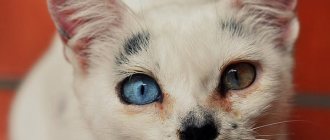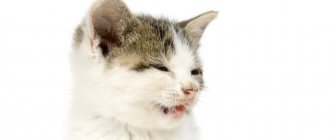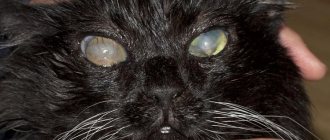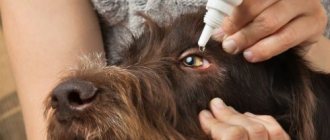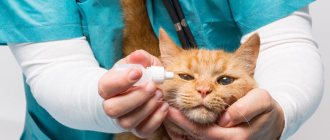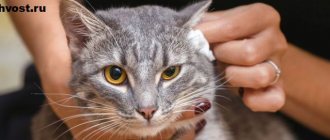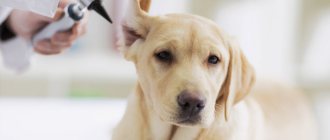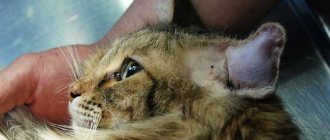Why do my eyes fester?
Kittens that were recently born are weak and susceptible to various diseases. Because of this, sometimes the kitten’s eyes become very purulent; the discharge can be so profuse that the baby’s eyes don’t even open.
There are many reasons for the occurrence of this condition, as well as eye diseases, and it is not always possible to find out why the kitten is suffering:
- virus;
- draft;
- speck in the eye.
All these are possible irritants that can cause the eyes of a small kitten to fester. One of the common causes of exudate is conjunctivitis. Among other things, a kitten can injure its eye while playing or conflicting with another pet. At first it may be a simple wound, which then becomes infected.
Little animals are very curious creatures, they strive to stick their nose somewhere. Sometimes the nose ends up in the wrong place and household chemicals, detergent, etc. get into the animal’s eyes. If the kitten's eyes are festering and sneezing, check the place where he sleeps; the cause of complications may be a cold due to a draft.
The kitten's eyes become purulent and swollen due to a disease called blepharitis. The disease occurs as a result of chemical, thermal, traumatic effects on the eyelids. The danger is not the damage itself, but the viruses, microbes and pathogenic fungi that infect the affected area. Inflammation of the cornea (keratitis) is another disease that causes a kitten’s eyes to fester and become swollen.
If the discharge is profuse and constant, the kitten should be shown to a veterinarian. The specialist will determine the root cause that caused the suppuration of the organ of vision and prescribe appropriate therapy.
Keratitis in cats
Another one of the most common ophthalmological diseases in cats. Keratitis is an inflammation of the cornea. You can recognize it immediately by a clouded eye.
This disease can also occur due to other reasons: foreign body, conjunctivitis, eye burns (difficult to treat), allergies, infection, vitamin deficiency, inflammation of the lacrimal glands, genetic predisposition (most often artificially bred cats are prone to this disease - Siamese, Persians, British).
In addition to clouding of the cornea, you need to pay attention to a number of symptoms that will confirm your fears:
- Manifestation of blood vessels;
- Severe photophobia;
- Fluid accumulation inside the eye;
- The appearance of scars (indicates that the disease is at the last stage and further treatment will most likely not bring any results).
As you probably already understood, independent treatment is contraindicated, and first you need to find out the causes of keratitis. You can examine the eye for the presence of foreign bodies, assess the general condition, but only a qualified veterinarian can determine the severity of the disease and prescribe treatment.
Cloudiness of the eyeball indicates the possibility of more complex internal diseases.
Symptoms
The symptoms of purulent discharge, as well as the kitten’s health condition, depend on the cause that caused the appearance of the ichor. Let's look at the main reasons why kittens develop problems and symptoms associated with each specific type of damage:
- Bruised eyelids. If the baby bruises the eyelid, then upon examination you can see a bruise, and adjacent tissues may be crushed. In severe cases, necrosis occurs.
- Wounds of the eyelids, in which the integrity of the kitten’s skin may be compromised, bleeding and pain may occur.
- Blepharitis. The first symptom of blepharitis is redness of the eyelids. If a kitten's eyes are red and festering, this is also one of the signs of illness. In the process of scratching, the pet introduces purulent microflora into the eye: streptococci and staphylococci. Swelling during illness is another symptom.
- Purulent conjunctivitis. Most often, the disease affects both eyes. The kitten looks sick, depressed, and may have a fever. At first, the purulent discharge is liquid, but as the disease progresses, it gradually thickens. The conjunctiva swells and may even protrude beyond the eyes.
- Follicular conjunctivitis. The disease is characterized by damage to the lymph nodes located inside the third eyelid. There is discharge from the conjunctival sac. There is photophobia and pain. The eyelids look swollen. Often the kitten’s eyes do not open and fester, because the ichor sticks together the eyelashes and forms crusts that prevent the opening of the eyelids. The pus irritates the skin around the eyes, which leads to inflammation, dermatitis and eczema develop, and hair loss around the affected area.
Eye Treatment Basics
At the initial stage of any disease that causes the appearance of exudate, the kitten experiences virtually no discomfort. As a rule, there is no harm to health. The problems start later. Pathogenic microorganisms develop, the amount of pus increases. The discharge begins to irritate the mucous membranes and skin around the eyes. If your pet is left untreated, the possibility of vision loss increases many times over.
Therefore, when a small kitten’s eyes fester, what to do, how and how to treat it are the first questions that the owner of the animal must decide. Let's start with first aid - rinsing. To wash your baby's eyes, make a chamomile decoction, wash off the accumulated ichor and rinse the inflamed eyeball. If you have other pets at home, repeat this procedure with them for preventive purposes.
If rinsing does not help, then it is better not to continue self-treatment. Take your baby to the veterinarian, only he can tell you exactly what to do next. Agree, why think about why a kitten’s eyes are festering, how to treat a sick animal, when there are people qualified to solve these issues. Yes, veterinary services cost money, but here it’s up to you to decide what’s more important – the baby’s health or an unplanned waste of money from the family budget.
Eye damage by helminths
It is believed that worms in the eyes of a cat is a myth, but you should know that theoretically these parasites can live in any organ. It is important to remember that helminths of this type are very dangerous and your pet may simply lose his sight if treatment is not started in time.
How do these parasites get into a cat's eyes? They require an intermediate carrier – fruit flies. They sit on the animal’s eyelids, lay eggs close to the mucous membrane, and when the pet washes itself, they inseminate it. After the development stage, the egg develops into a larva, which moves into the eyeball and begins to grow.
Symptoms that indicate that the eye is affected by helminths:
- Loss of eyelashes;
- Itching in the eye area;
- lacrimation;
- Inflammation of the mucous membrane and cornea
- Cloudiness
- Increased body temperature
- Deterioration of vision (blindness)
This symptomatology is well known to us and is very similar to other ophthalmological diseases that we have already listed. A definitive diagnosis can only be made in a clinical setting.
Therapy
Treatment of purulent discharge is primarily aimed at eliminating the cause of the pathological process. Further treatment measures depend on how correctly it is established. Treatment for purulent eyes in a kitten also depends on the causes of the pathology:
- If the cause is a bruise, the injured area is cleaned with a gauze swab soaked in a solution of hydrogen peroxide. The same applies to wounds of the eyelids.
- If the problem is blepharitis, they look for and remove the cause. It is worth knowing that blepharitis in a kitten can occur due to a lack of vitamins, so if the doctor has diagnosed it, it is necessary to provide the pet with a balanced diet with vitamin supplements.
- When a kitten has snot and purulent eyes due to a cold, the doctor prescribes eye drops and antibiotics. It is important to provide your pet with comfortable living conditions. The baby's crib should be dry and warm, and there should be no drafts in its location. Adding vitamins to your pet's diet will be an additional benefit for the baby's health.
- If the kitten's eyes cannot open due to pus, the exudate crusts are softened before removal. Vaseline oil is used for this purpose. The softened crusts are removed, and the area around the eyes is treated with hydrogen peroxide. The eyes themselves are washed with nitrofural, also known as furatsilin. After treatment, eye drops are instilled or ointment is applied.
Some kitten diseases cause not only discharge from the eyes, but also pain. In such cases, the veterinarian prescribes novocaine with an antibiotic, which is injected into the conjunctival sac.
If the disease is advanced, the bacteria have time to take root firmly in the deep layers of the eye. In this case, the doctor prescribes general antibiotic therapy.
For purulent or phlegmonous conjunctivitis, general and local therapy is used. The course of treatment includes periodic washing of the eyes with boric acid - 3%, and their subsequent treatment with syntomycin ointment or any other eye emulsion with antibiotics. In this case, novocaine blockade with an antibiotic is also used. In addition to the pronounced “freezing” effect, the procedure is useful in general therapeutic terms. Antibiotics can also be administered intramuscularly. In addition, your veterinarian may recommend oral sulfonamides.
How to treat
Here we will look at the means that are commonly used to wash, wipe, and apply drops to a kitten’s eyes if there is purulent discharge in them. Here is a list of the most commonly used medications:
- drops "Bars";
- tetracycline ointment;
- “Diamond Eyes” drops;
- multifunctional drops "Iris";
- “Anandin – drops with an antiviral effect;
- eye drops "Lakrikan" - for non-viral inflammations;
- "Tsiprovet" in tablets or drops for the treatment of inflammation caused by bacteria.
Most often, the instructions for use indicate the optimal dosage of the medicine, but on average, if a one-month-old kitten has festering eyes, one drop of the drug three times a day is enough for the baby; older pets are instilled with 2 or 3 drops of the prescribed drug.
The medicine is instilled as follows: the lower eyelid is slightly retracted and the drug is applied to the mucous membrane. Make sure that the product does not leak out; for more reliable instillation, the animal’s head can be raised so that the eyes look up.
As improvised means, you will need cotton swabs and a special lotion. But if there is no lotion, you can use chilled boiled water.
Causes of eye tumors in cats
Here is a list of diseases why such a symptom as swollen eyes appears in a cat:
- Trauma or bruise
- Foreign body
- Entropion (etripon)
- Conjunctivitis
- Keratitis
- Eye damage by helminths
- Tumor
Each disease has additional symptoms that can indicate the nature of the problem and ways to solve it. We will talk about them below.
Pay attention to your pet's behavior - this will help you more accurately identify the problem.
How to put drops in a kitten's eyes
A small pet must be handled carefully, and before washing the kitten’s festering eyes, you need to figure out how to hold the animal so as not to injure or frighten it.
Place your baby on his back with his face pointing up. If the kitten's eyes do not open, soak the eyelids with chamomile infusion or boiled water. After this, remove the pus and only then instill the medicine.
On average, therapy lasts about a week, but much depends on the degree of neglect of the disease and its nature.
Remember, self-medication should be used only in one-time cases of purulent discharge. If ichor is constantly secreted, abundantly, and there are other symptoms of a dangerous pathology, use the services of a specialist. As an example, with conjunctivitis, a kitten should be examined for chlamydia. Another examination is needed to find out how tolerant the pet is to antibiotics.
Among other things, the veterinarian knows exactly what treatment to prescribe in each individual case, which greatly increases the chances of successfully resolving the situation and, as a result, the kitten maintains full vision and health.
What to do if your eyes fester with a runny nose
If a kitten has a runny nose and festering eyes, this does not mean that this will all end. After all, such deadly diseases for a young body as calicivirus and viral rhinotracheitis begin with a runny nose. Therefore, timely diagnosis in this case is an important factor.
A runny nose may also be of an allergic nature or indicate bronchial asthma. Each individual situation requires a specific approach to treatment, which is why diagnosis is a priority here too.
As soon as you see that your kitten’s eyes and nose are festering, consult a doctor. Each animal is a small individual, and if your neighbor’s cat got away with a slight illness after a runny nose, this is not evidence that everything will go well for you. Do not forget that we are talking about a baby with weak immunity.
Purulent discharge of a cold nature is treated with antibiotics, anti-inflammatory drugs and immunomodulators. Much attention is paid to preventive measures - eliminating possible drafts and hypothermia of the pet.
What to do for prevention?
Suppuration and inflammatory processes affecting the organs of vision are a common phenomenon that is often diagnosed not only in kittens, but also in adult cats. To prevent dangerous complications and prevent the disease from reoccurring, it is recommended to take the following preventive measures:
Following the vaccination schedule will help protect your baby from such manifestations.
- Regular care. It is recommended to constantly inspect the kitten’s eyes and, when dirty, wipe them with a cotton swab dipped in a herbal bactericidal decoction.
- Timely vaccination. By following an individually drawn up vaccination plan, it will be possible to protect the animal from dangerous viral infectious diseases, most of which are accompanied by purulent discharge from the eyes and nose.
- Timely deworming. It is important to prevent your pet from becoming infected with fleas and ticks. In addition, once every 3 months it is worth giving your baby anti-worm medications.
- Boosting immunity. In order for the body to successfully fight pathogenic microorganisms, on the advice of a doctor, it is recommended to add useful supplements and vitamins to the kitten’s food.
It is important to take care of the kitten, give it love and affection. Scientists have proven that happy four-legged friends are less prone to various diseases than others. And if it happens to get sick, the pet recovers and recovers much faster, because an attentive owner notices the problem in a timely manner and immediately takes active steps to help quickly get rid of any pathology, including ophthalmological ones.
Why do a kitten's purulent eyes swell up?
There are several possible reasons for the described symptoms:
- allergy;
- chlamydia;
- mycoplasmosis;
- toxoplasmosis;
- calicivirus infection;
- herpes virus infection, etc.
To find out what infection has affected the kitten, a PRC diagnosis will be required, and only after the diagnosis has been clarified can treatment of the animal begin. You should also consider factors such as:
- time of last deworming;
- time of the last vaccination of the animal, type of vaccine;
- what additional vitamins were used to strengthen the body.
Please note that feeding a kitten with economy class food is not recommended. And we are talking about any product: both wet and dry food. It has been proven that consumption of these products by a pet provokes gastrointestinal diseases, which leads to the development of infections affecting the eyes.
